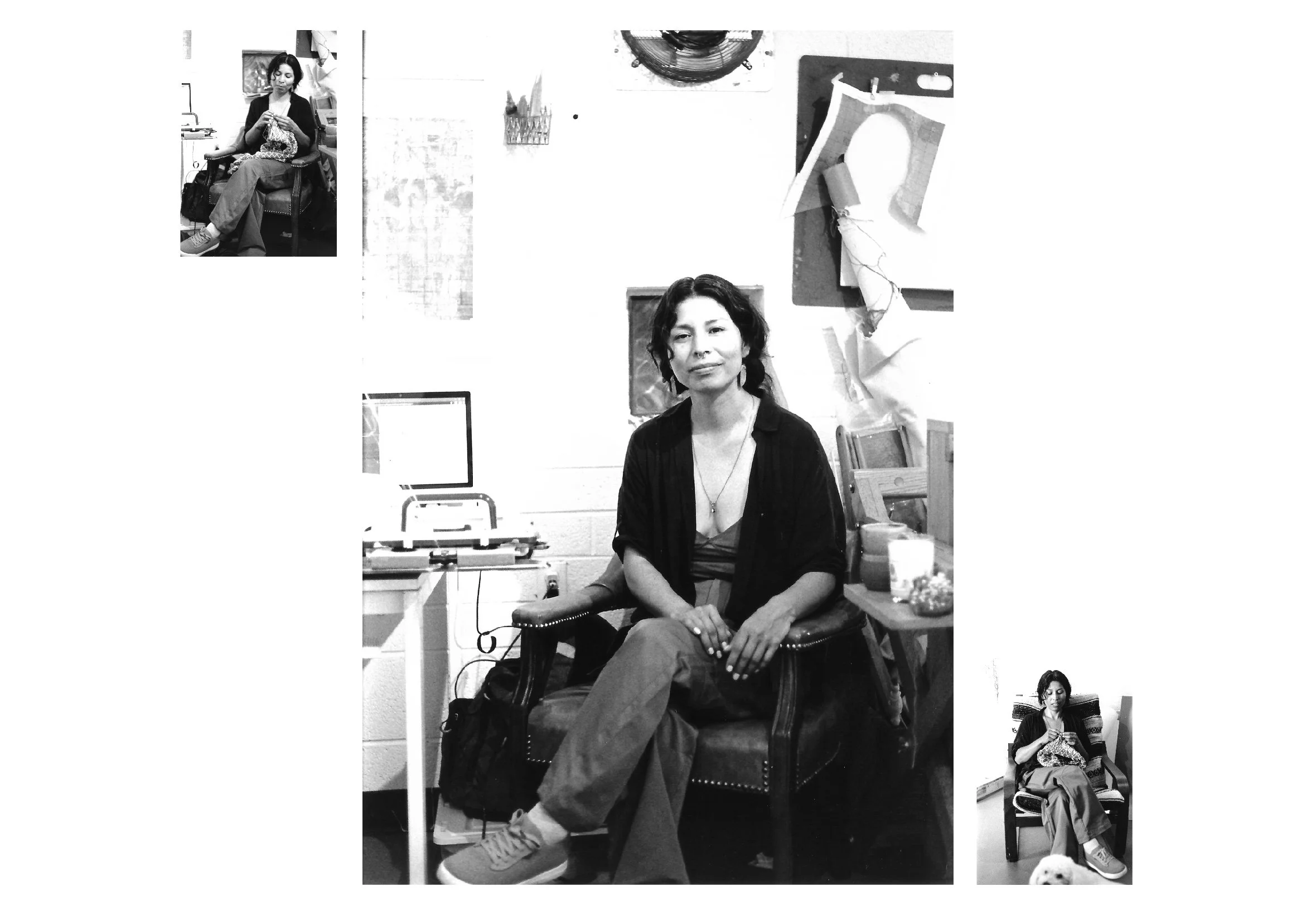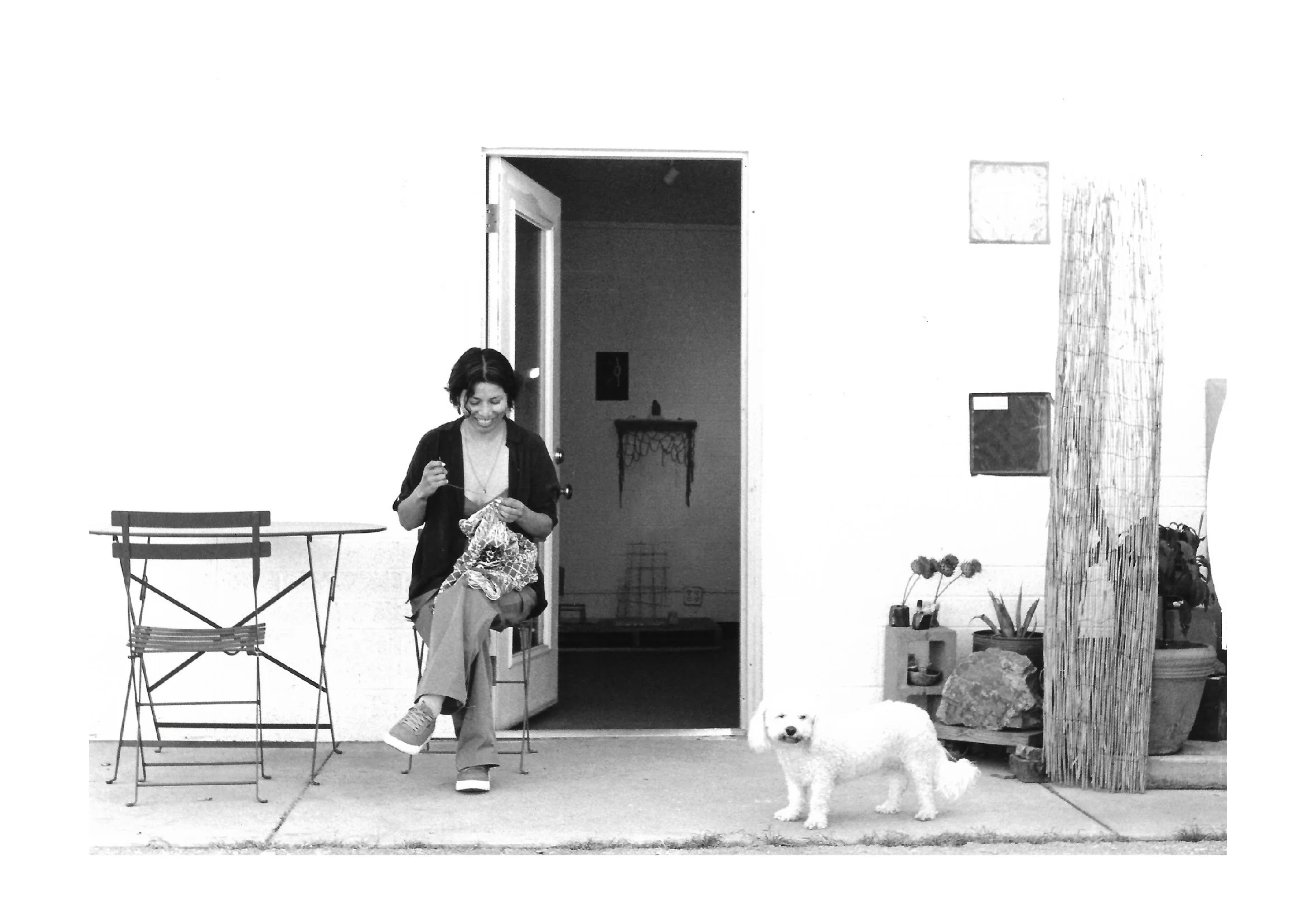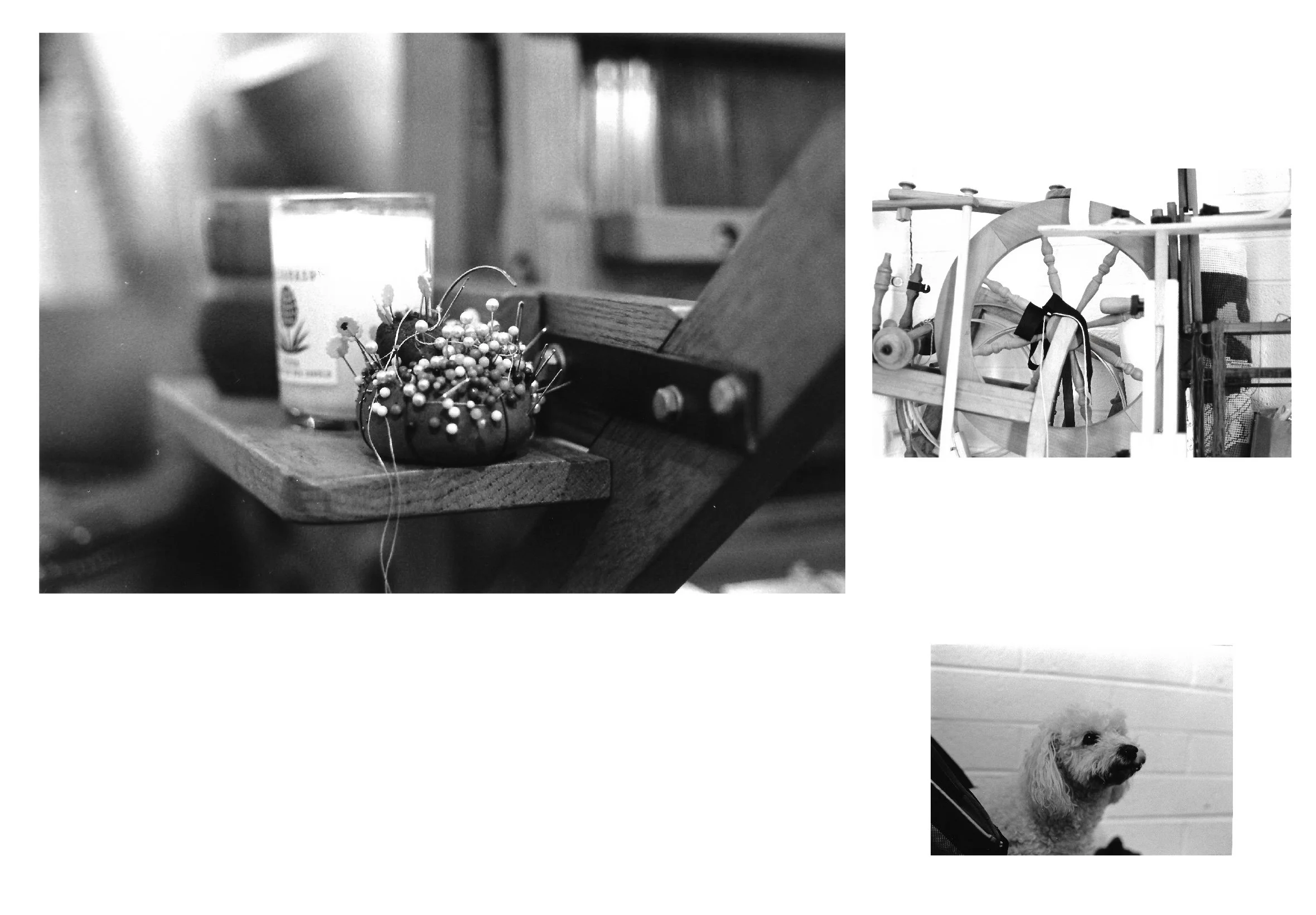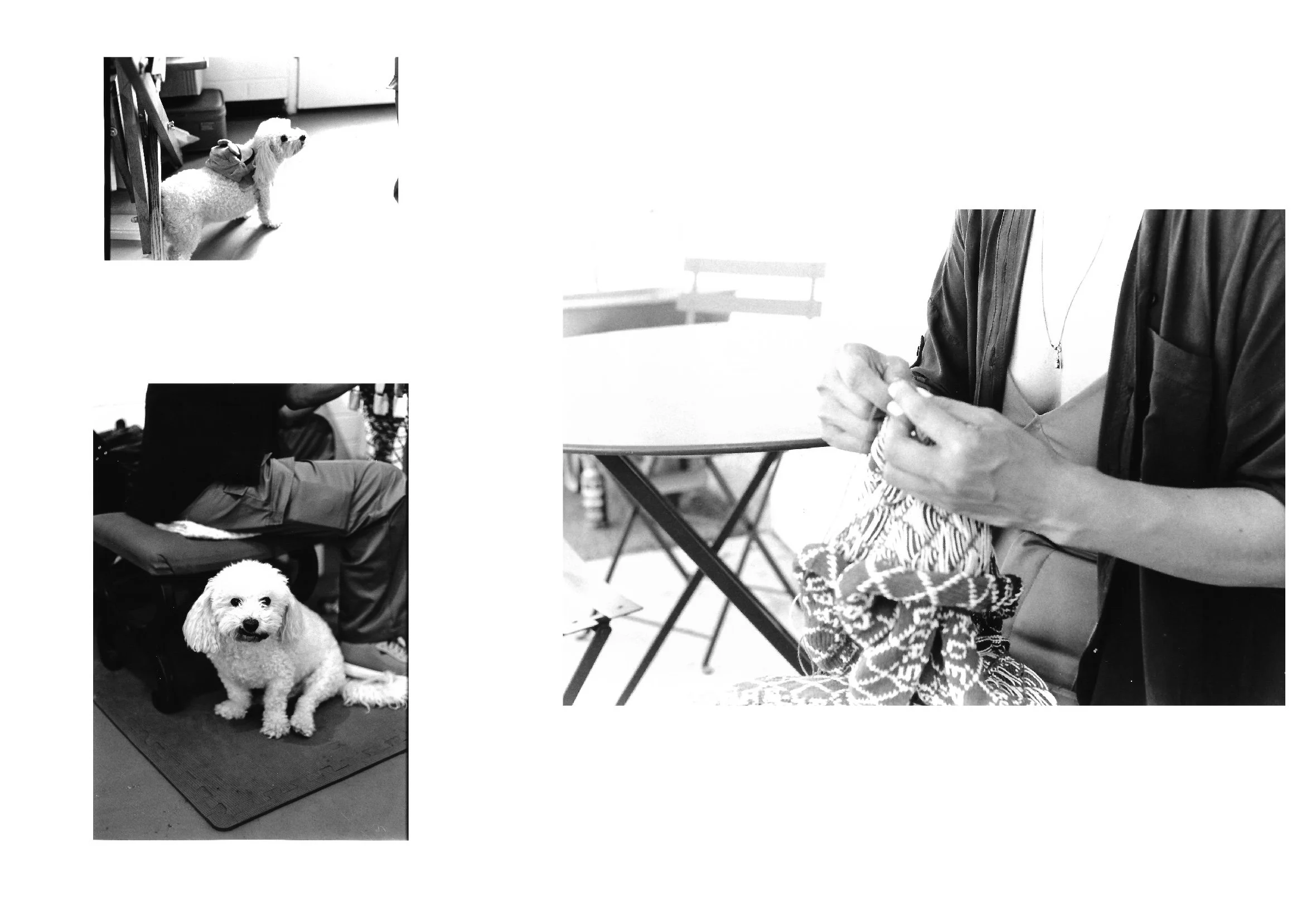In Conversation With Gloria Martinez-Granados: Interview VI
“IN CONVERSATION WITH” IS A CONVERSATIONAL INTERVIEW SERIES WHERE WE SIT DOWN WITH CONTEMPORARY ARTISTS AND DISCUSS TOPICS THAT ARE IMPORTANT TO THEM.
(All conversations are recorded, and transcribed by BrassTuna.)
This conversation has been edited for length and clarity
“Gloria Martinez-Granados is a Phoenix, Arizona based artist. Originally from Guanajuato, Mexico she migrated to the United States of America with her family at a young age. Much of her work is inspired by her experience growing up undocumented and from the colorful textiles of her native Mexico. She enjoys working with traditional methods with a contemporary take using a variety of mediums such as printmaking, fiber arts and beadwork.”
(Biography from borderlesscreative.com)
(Silver Gelatin prints, hand printed by BrassTuna)
BrassTuna: Hello Gloria, thank you so much for joining me today-
Or, actually, thank you for having me over today, here in your studio!
It’s been a pleasure being here over the last couple of hours haha!
Would you mind telling our readers a bit about yourself?
G.M.G: My name is Gloria Martinez-Granados, I am an artist based in Phoenix, Arizona. The work that I do centers around my identity as an undocumented person, and I am trained as a printmaker, but I have a very interdisciplinary approach.
It's mostly rooted in fiber arts and printmaking, which I feel both of those things give you a lot of variables to kind of play around with. My work kind of requires that, being that I heavily rely on the materials to expand on the narrative.
That's kind of a little about what I do ,,, and being that I am from Guanajuato, a lot of my art is very much expressive through the colors and the materials that I work with. The imagery that I choose to work with all kind of ties back to my heritage as a Mexican person.
*Looks across room* BT: This isn’t the first question, but I forgot to ask earlier, what exactly is this machine?
G.M.G: *Haha* I wouldn’t expect anyone to identify that machine; it’s actually from the ‘70s. It’s a knitting machine. So if you think of, like a sewing machine, its basically the same thing. It will knit for you faster, in the same way that a sewing machine would sew for you faster.
And it has different settings on it so that you can create different stitches.
It literally just has these little hooks, and when you run the base that is sitting on top of it back and forth, it will knit rows for you.
So, something that would take you months to make will literally take you a few hours. You can even have your own design on a punchcard to make your own patterns, too.
BrassTuna: It's just funny because we have been sitting here for a while, and I kept looking over, and it never registered in my mind.
G.M.G: You can see this one that is finished here,,,
BrassTuna: Oh, so there are words on this piece, too?
G.M.G: Yeah, so this is one of the new pieces that I am working on. Eventually, all this fabric is going to be joined together, and it’ll be a big piece of cloth that will create a wall.
So it’s sculptural, and also kind of in an ‘installation’ type of way.
It’ll be something that can be velcroed, and then you could velcro it off.
BrassTuna: So this will take up the entire space of a wall?
G.M.G: Yeah, so it’ll end up measuring 4’x8’ feet, and it’ll be about a foot and a half wide.
The machine is really interesting to me when creating in this, too, because you have to understand the machine. There are so many different things about it.
For one, they are replicating what a human body would do. Then, the machine itself holds the tension of what the hand would do.
And each setting is going to change, and whatever material you are working with is gonna also change the ways those settings are set.
So if you’re working with some fabric, and the fabric is very thin, and you have very thin yarn or string, then it'll be a little bit faster on certain settings.
Whereas if you’re using a thicker material and thicker string and you have it on those same settings, it’s not going to have the same speed.
So I think that's what interests me with the machines is that they are replicating what the human body would naturally do, and then we, as humans, have this tool that makes it more accessible and faster to create.
But you also have to have that knowledge, and you have to invest those hours with this machine, get to know it, get to understand the tension that goes with that, and then also every material that you work with will also change up whatever knowledge you’ve built on to that.
(Silver Gelatin prints, hand printed by BrassTuna)
BrassTuna: Does this specific piece have a name or a title?
G.M.G: I don't have the final title for the piece yet.
With this piece, I was really interested in thinking about the word ‘abolish.’
I feel like my earliest memory of ‘abolishment’ was learning it in world history and thinking about the abolishment of slavery here in the United States.
You know, it's like a word that you’re so familiar with, but I feel at the same time you’re so distant from it. It’s not something that you feel is still occurring.
Abolishment of slavery meant it was a cruel practice to society as human beings. That was something that we understood needed to change at some point in time, and now currently, we are still seeing how the effects of slavery still continue to oppress African American people.
And we are not acknowledging those oppressions currently, like how we had the Black Lives Matter movement, and we still haven’t seen any policy that changes the way that police brutality still continues to affect our communities.
And then also thinking about it in the narrative of me as an undocumented person.
I always think about the criminality of that and the ways that my body is moving through land and entering a space that I had no permission to enter into.
Thinking about how that ties to Native American peoples. Talking about having movements like ‘Land Back,’ upholding the treaties that were made so that people could keep access to their own land.
I think because of those two very specific things that are very prominent for us here in Arizona, living on Indigenous land ,,, thinking of those things, I felt I needed to go back to this word ‘abolish.’
I also combined it with ‘borders,’ thinking of what abolishing a border looks like.
If a border is what keeps people feeling safe, what other ways can we feel safe?
So with this piece, I thought it’d also be interesting to print it on something so soft, on this yarn material, and just thinking about these very simple words.
It’s not something you would typically tie it to. Then, it’s pattering, too, is replicating a chain link fence.
At the same time, it doesn’t because that pattern is so prominent in any kind of pattern that you see on fabric.
BrassTuna: Were the color choices something you chose, or did they come about naturally?
G.M.G: The color choices are very specific,
So, I'm working with green, white, and blue.
BrassTuna: What was the specific reason for those color choices?
G.M.G: It’s because I’m thinking about the U.S./Mexico border, so kind of like mashing up those colors together, and then also as I continue this work, I’m seeing those parallels of thinking about Palestine, and what’s happening in Gaza.
Thinking about those types of borders, the way that military expansion ,,, U.S. military expansion ,,, on other people's freedom, and how that also is a way of expanding this violence. Like, what does that mean when we have an oppressed people that can go through genocide in the modern-day over a piece of land?
And not being able to have conversations to find resolutions, and just straightforward going to violence.
If it happens to one, it happens to all. So it’s definitely inner connections that we have to acknowledge, and I think because of social media and the way that information is more accessible, we are more aware of all those intersectionalities of oppression and the ways that underlying white supremest systems really extend out to make sure that people who are oppressed continue to be controlled and continued to be exterminated.
(Silver Gelatin prints, hand printed by BrassTuna)
BT: Do you find it to be your arts main purpose to connect those ideas of culture and identity?
G.M.G: I think those things happen naturally in my own personal art practice because I have chosen to really focus on my identity and exploring what that means. I think it just naturally develops.
What I mean by that is that I started off making jewelry, and one of the things that really inspired me was Mexican jewelry. So I was looking at these symbols and these colors and creating off of that, and as I've started to expand on my skill sets, that never leaves you. Your culture is part of your expression, whether it is something that's intuitive or something you haven’t really recognized yet.
I think the work itself, coming back into the studio and creating new work it speaks back to you. It's through the repetition of creating that the narrative begins to formulate, and you begin to see what the work is saying to you. Part of art making isn’t just making the piece. It’s the interactions that you have with others.
I think because my work explores not only my identity but also this very curious space that I find myself in as a DACAmented person, and the ways that my life is such a political control over how I plan my life moving forward, or what I can and cannot do, it definitely puts my mindset in that perspective. I think the only way I can kind of make some sense of it is to look at things historically, and to see how it is that we got here.
I think that those things kind of formulate together. I don’t think I planned it out to be like, “Oh, I’m going to create work about identity,” and “This experience about a migrant person,” it's more about you coming into this space and your art practice is a healing practice. So having this space to just be creative and to sit with your feelings, and to kind of just explore what and where those feelings are coming from. Being able to connect with them through different materials, and different symbols and imagery, sights and sounds, and whatever it is that you want to work with. I think all of those things work together to form the work that comes out.
BrassTuna: Reflecting back on when you first started your art-making practice, I imagine it was in your early school years; what was your process like when beginning?
G.M.G: Being that art wasn’t something that I saw myself doing as a child of an immigrant, I thought something in healthcare, or a lawyer, or something that is consistent pay. When that didn’t work out, I ended up falling back on a skillset that I learned in high school, which was making jewelry.
Thinking before that, I used to be in a photo club back in seventh grade, so we would do the whole shooting on film, developing, and printing, and that still becomes part of my practice, though I wouldn’t call myself a photographer. I always laugh when someone compliments my photos because I shot it on my iPhone. *haha*
I understand that there is a level of respect that is held for photographers, being able to shoot film requires a lot of skill, and a lot of time to be able to sharpen those skills. So, I now have access to a digital camera on a phone, which would probably be able to capture a photo so much better than I could on film. *Haha*
But I do have to honor that part of that creative flow directly stems from photography first, and then it kind of just develops into something else. I think that the most important respect that I hold for my art-making is not having an expectation. Just something a simple as that is not holding any expectation of what the final result is, and being very present during the process of making it.
I feel like that has been such a vital thing for my art work, to be able to expand with.
(Silver Gelatin prints, hand printed by BrassTuna)
BrassTuna: Do you feel like your educational background was very important to that development in your work?
G.M.G: Yeah, definitely. I don’t think that that’s a thing for everyone. I don’t think everyone needs to go to school to be a good artist.
For me I thrive on structure, I need structure. So being able to have gone through, stepping into the art scene without any formal education, and having that hands-on experience of putting on a show and creating work for the show ,,, talking to people about the work, and then having formal training in school, I feel that it definitely helped me to have some sense of an expectation in this case.
Because it is a choice that you make whether you go to school or not, it's a great financial choice that you make, and it affects everything else because you really need to be able to focus that time just to concentrate on school.
Art school is not easy. I feel like a lot of my friends who know that I went to nursing school kind of diminish that art school was also ,,, I’m not going to say that one is harder than the other because they are very different, but I think each one holds its true value in different ways. The fact that people diminish art in such a great way really says a lot about our society, but I feel that school was definitely something that really helped me to have that artistic practice that I wouldn’t have been able to know unless I was actually active in it. So having these classes and having instruction, having expectations, but then also having the ability to know myself as an artist and to honor myself as an artist and to say, ‘I’m in school, and this is the assignment, but maybe I’m ok with the instructor giving me a lesser grade because I don’t need this expectation but I’m going to make something I want to make,’ those were some choices that I made personally.
I would rather get a B or a C if I am not fully doing the project you wanted me to doubt I’m going to be able to show this piece; it’s not going to be a piece that is fully under your instruction of whatever the prompt was of the theme you wanted me to make.
BrassTuna: Your pieces you were making in school, what were some of the main subject matters you were focusing on then?
G.M.G: When you were taking instruction from teachers, it would be themes around maybe a ‘universe,’ or some social justice issue that might’ve been important to you, or very general themes. So I feel that a person who’s an artist who’s just starting out, specifically thinking of someone who is very young, though you don’t have to be young not to have a full understanding of what you want to do, you could be any age.
But I feel that for younger people, going into something like art school is a lot more challenging because you don’t have that life experience of what may be out there for you, whereas someone who may be older might already have experience being in those spaces.
I think that's something that ,, not having that very linear path ,, stepping into that space can be very helpful because you have an understanding of where you’re at and what this institution can offer you.
But if you don’t have that understanding, how do you know what direction you should be taking? How do you know what is necessary of you as the creative to be producing with the circumstances that you have at hand. So you know, having access to an instructor who is an expert at this technique, or having other students that you can bounce ideas off of, or even if you forgot a step in the process you can ask them how it’s done. Or if you need an extra hand, they are there to help you out.
So those types of tools that are available to you in that kind of environment, if you aren’t able to identify things like that, then it makes it almost impossible to understand that ‘here you have access to a studio,’ you know? Take advantage of this opportunity, these are things that you just generally don’t know.
(Silver Gelatin prints, hand printed by BrassTuna)
BrassTuna: As we reach the end of the interview, I want to ask you a couple of speed-round questions.
First, who is your favorite musical artist?
G.M.G: Right now, I would have to say, Kendrick Lamar.
BrassTuna: Oou, that’s a good choice!
Who is an artist you feel inspires you heavily?
G.M.G: That’s a hard one. I don’t think I could say just one.
Frida Kahlo definitely was someone that I collectively got to enjoy with other artists. My father-in-law Martin Moreno, seeing him do his murals and the ways he connects to the community through his murals. I think just as a contemporary artist like Jose Villalobos, there are so many, Estrella Esquilín and Annie Lopez, like I feel artists thrive off of each other.
So having one artist is just not gonna happen *Haha*
BrassTuna: What is one piece of advice you would give to the next generation of Latin American artists today?
G.M.G: I would say that the advice for any artist, at any time, is to step in and be present. I feel that it is such an important task, and it's not just a task, but it’s a privilege to be an artist and to have the time to process all these different things.
Such as the way color looks or the ways sound can inspire you, or the ways that we can present things to others, and what we create off of that.
So I think just continuing to be present in our work is such an important task.
BrassTuna: Thank you for your time today Gloria, its’s been an honor to talk to you and hang out with Santo!
You can find Gloria Martinez-Granados on their Instagram (@Borderlesscreative) as well as their website www.borderlesscreative.com
(Stay up to date on future BrassTuna “In Conversation With” interviews by following us on Instagram)
This Interview is Part I of BrassTuna’s “October 2024” publication.
Check out Part II “La Sirena” on Instagram (@brasstuna) and BrassTuna’s first installment of “In Conversation With: Exhibition Review I” Out Now





